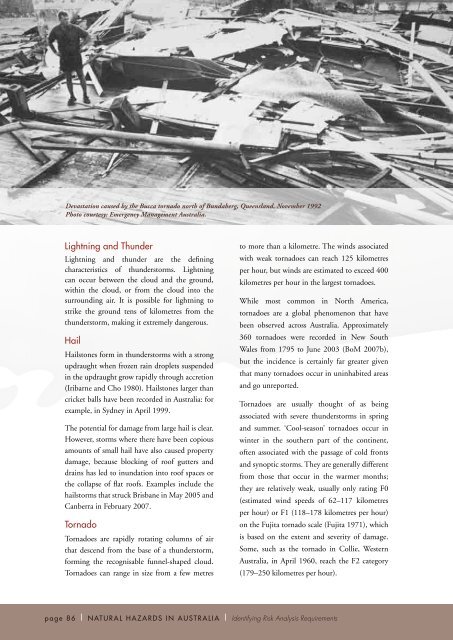Severe Storm - Geoscience Australia
Severe Storm - Geoscience Australia
Severe Storm - Geoscience Australia
Create successful ePaper yourself
Turn your PDF publications into a flip-book with our unique Google optimized e-Paper software.
Devastation caused by the Bucca tornado north of Bundaberg, Queensland, November 1992<br />
Photo courtesy: Emergency Management <strong>Australia</strong>.<br />
Lightning and Thunder<br />
Lightning and thunder are the defining<br />
characteristics of thunderstorms. Lightning<br />
can occur between the cloud and the ground,<br />
within the cloud, or from the cloud into the<br />
surrounding air. It is possible for lightning to<br />
strike the ground tens of kilometres from the<br />
thunderstorm, making it extremely dangerous.<br />
Hail<br />
Hailstones form in thunderstorms with a strong<br />
updraught when frozen rain droplets suspended<br />
in the updraught grow rapidly through accretion<br />
(Iribarne and Cho 1980). Hailstones larger than<br />
cricket balls have been recorded in <strong>Australia</strong>: for<br />
example, in Sydney in April 1999.<br />
The potential for damage from large hail is clear.<br />
However, storms where there have been copious<br />
amounts of small hail have also caused property<br />
damage, because blocking of roof gutters and<br />
drains has led to inundation into roof spaces or<br />
the collapse of flat roofs. Examples include the<br />
hailstorms that struck Brisbane in May 2005 and<br />
Canberra in February 2007.<br />
Tornado<br />
Tornadoes are rapidly rotating columns of air<br />
that descend from the base of a thunderstorm,<br />
forming the recognisable funnel-shaped cloud.<br />
Tornadoes can range in size from a few metres<br />
to more than a kilometre. The winds associated<br />
with weak tornadoes can reach 125 kilometres<br />
per hour, but winds are estimated to exceed 400<br />
kilometres per hour in the largest tornadoes.<br />
While most common in North America,<br />
tornadoes are a global phenomenon that have<br />
been observed across <strong>Australia</strong>. Approximately<br />
360 tornadoes were recorded in New South<br />
Wales from 1795 to June 2003 (BoM 2007b),<br />
but the incidence is certainly far greater given<br />
that many tornadoes occur in uninhabited areas<br />
and go unreported.<br />
Tornadoes are usually thought of as being<br />
associated with severe thunderstorms in spring<br />
and summer. ‘Cool-season’ tornadoes occur in<br />
winter in the southern part of the continent,<br />
often associated with the passage of cold fronts<br />
and synoptic storms. They are generally different<br />
from those that occur in the warmer months;<br />
they are relatively weak, usually only rating F0<br />
(estimated wind speeds of 62–117 kilometres<br />
per hour) or F1 (118–178 kilometres per hour)<br />
on the Fujita tornado scale (Fujita 1971), which<br />
is based on the extent and severity of damage.<br />
Some, such as the tornado in Collie, Western<br />
<strong>Australia</strong>, in April 1960, reach the F2 category<br />
(179–250 kilometres per hour).<br />
page 86 | NATURAL HAZARDS IN AUSTRALIA | Identifying Risk Analysis Requirements

















